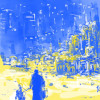#Legal Framework
The Publication is aligned with INED’s commitment to promoting open science and the unrestricted dissemination of research publications and data. Furthermore, and unless otherwise specified, the texts and recordings published via the Publication are covered by a Creative Commons licence, as described in the section entitled “Content under open licence” below. Content for which the authors have not agreed to publication under a Creative Commons licence or could not be identified remains subject to the standard copyright terms set out in the section “Content under copyright”.
Content under open licence
Some content reproduced in the Publication is labelled, within the description, as “Creative Commons licence”. This is true for the extracts of the interviews conducted as part of the Sound Archives: European Memories of the Gulag project, as well as for articles published in the Publication. (The full interviews, however, may be subject to restrictions for data protection reasons. The terms of use are given in the database).
The Creative Commons label signifies that the document is a work that is subject to copyright, but that its author has chosen to apply a type of open licence, a Creative Commons licence, to its use. This type of licence allows the author of the work to make the content freely accessible online by granting all or some of the economic rights they hold as author. As such, this system allows users to reuse content without first asking the author for permission. As for the author, using an opening licence enables them to be credited and cited in the way they wish.
Within the publication, the content governed by an open licence may be distributed and reused under certain conditions.
The Creative Commons licence applicable to works reproduced within the Publication is as follows:
![]()
This open licence allows users of the Publication, and INED, to use the work subject to compliance with the following rules:
Attribution: Use of the work is subject to the obligation to credit its author and provide a link to the licence.
Non-commercial: The work (in its entirety or any component of it) may not be used for any commercial purpose.
No derivatives: The work may not be modified (transformed, translated, or incorporated into a new work) and then distributed or made available to the public
This licence therefore permits Publication users and INED to copy and distribute the work via any media and in any format, but only without modifications, for non-commercial purposes, and provided that the author is cited.
Public domain
Some content reproduced in the Publication is labelled in the description as “Public Domain”.
A work falls into the public domain seventy years after the death of its author. From that point on, it is no longer possible to hold exclusive economic rights over the work. In this situation, Publication users and INED may reproduce the work without asking rights holders for permission. Warning: this only relates to the economic rights attached to the work. Use of the work must still respect the moral rights of its author (right to respect for their name and their work, right of disclosure, and right of withdrawal). This means that the author of the work must still be credited and that the integrity of the work must be respected.
Content under copyright
Some content reproduced in the Publication is labelled in the description as “Under copyright”. This includes primarily photos and personal documents obtained during the programme of interviews conducted for the Sound Archives: European Memories of the Gulag project.
This label signifies that the document is considered a work to which the copyright rules apply. Its author therefore holds an intangible and exclusive property right over it.
The author of the work holds two types of rights:
- Economic rights: these confer the opportunity to make commercial gain from the work throughout the author’s life and for seventy years after their death. In practical terms, they give the rights holder the right to reproduce or present the work. These rights may be transferred, in whole or in part, by the author of the work to a third party.
- Moral rights: these govern the terms under which the work is disclosed or withdrawn and protect its authorship and integrity. In France, these rights are perpetual, inalienable and imprescriptible. As such, they may not be transferred.
Despite INED’s desire to promote free access to the information and content reproduced in the Publication in line with its open science policy, it is bound by copyright rules where rights holders have not wished their work to be accessible and usable under a Creative Commons licence or where they could not be identified.
To learn more about the terms for the reuse and reproduction of documents under copyright, see the section below entitled “Distributing or reusing content under copyright”.
Distributing or reusing content under copyright
As a precaution, before making any use of content, users must bear in mind that it could be subject to copyright. However, even if a user does not have permission to use the work, they may potentially take advantage of the copyright exceptions provided for under French law, which allow third parties to use a work protected by copyright without the rights-holder’s authorization.
For example, use of a work under copyright, reproduced in the Publication, is permitted in the following circumstances:
- When the work is being used for private purposes. This includes private copies made of the work (reproduction on any medium for private use) and even performance of the work to family members.
- When the work is being used for the purposes of parody, pastiche or caricature.
- When the work is being used by legal entities, establishments open to the public, such as libraries, archives, documentation centres, and multimedia cultural spaces, for the purposes of the strictly personal viewing of the work by people with one or more impairments in motor, physical, sensory, mental, cognitive or psychiatric function who, due to these impairments, are prevented from accessing the work in the form in which the author makes it available to the public.
- When the work is being used for the purposes of conserving or preserving conditions for its consultation by individuals for research or private studies, in the premises of the establishment and on dedicated terminals in libraries accessible to the public, museums, or archiving services, provided the latter are not seeking any commercial benefit.
- When use of the work involves the total or partial reproduction or representation of a graphic, sculptural, or architectural work in the written or audiovisual press or in public online communications for the exclusive purposes of providing immediate information, and in direct relation to such information. This exception requires that the author’s name be clearly indicated and does not apply to works, particularly photographic or illustrative works, that are themselves informative in nature.
- When use of the work involves a digital copy or reproduction made from a legitimate source for the purposes of exploring texts or data included in or associated with scientific literature for the purposes of public research, excluding any commercial purposes.
- Subject to clear indication of the author’s name and the source:
- Analyses and short citations justified by the critical, polemical, educational, scientific, or informative nature of the work in which they are used
- Press reviews
- Reproduction and representation of extracts from works for exclusively illustrative purpose in the context of teaching and research, intended for an audience composed mainly of school or university students, teachers or researchers directly involved in the study of the work, without any commercial use, and compensated with a negotiated fee. This exception does not apply to works created for educational purposes, musical scores, or works created for digital publication of the written work.


